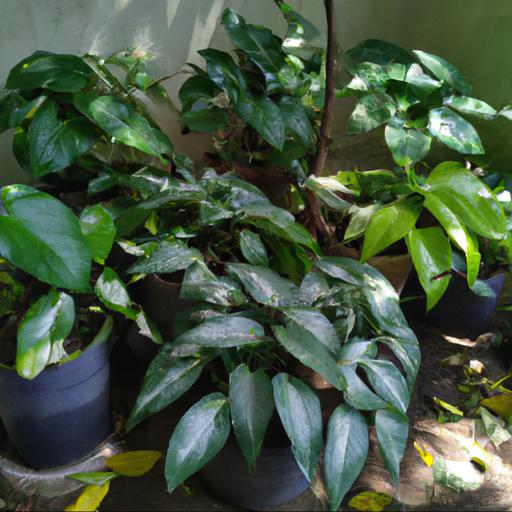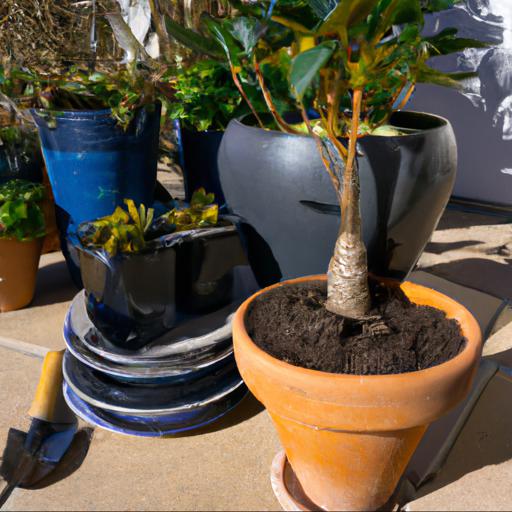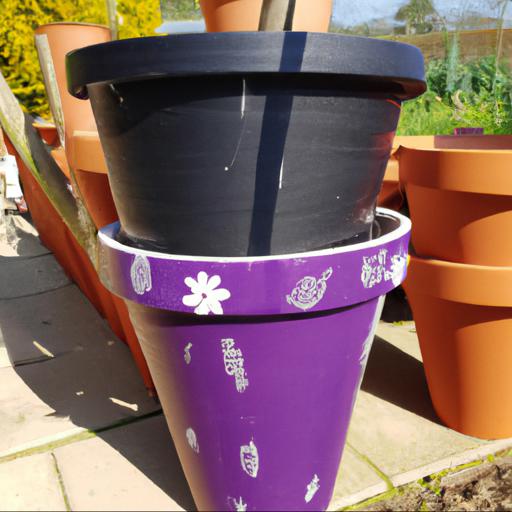Are you looking for the perfect spring pots for your shady spots? With the right plants and containers, you can create a stunning oasis in your garden, even in the darkest corners. From bright foliage to fragrant blooms, there is a wide selection of plants that can thrive in shady spots.
With the right combination of containers and plants, you can create a beautiful spring pot display that will bring life to even the shadiest of spots. With a bit of planning and creativity, you can transform your shady spot into a lush and vibrant garden.
Benefits of planting spring pots in shady spots

Gardening experts know that planting spring pots in shady spots has many benefits. From providing beautiful blooms that can’t tolerate full sun, to enhancing a planting area with unique foliage and texture, spring pots in shady spots offer an array of advantages to anyone who takes the time and effort to gain the most from their garden. By planting a variety of plants, spring pots in shady spots add beautifying elements that traditional flower beds cannot provide.
For example, if you are looking for an emerald green foliage for a part of your garden that gets a few hours of dappled sunlight throughout the day, you could select a variety of ferns or hostas, or perhaps a combination of both. Simply imagine the tiny ferns emerging from the lush, green hostas.
The result would be an amazing low maintenance garden that provides fantastic texture and color. Another advantage of spring pots in shady spots is that they offer practically endless possibilities.
When tending to the area, you can create your very own oasis of exotic blooms or vegetables, as well as native grasses and perennials. You can also choose to recycle and reuse materials for containers by taking discarded items, such as old buckets, tires and kiddie pools, and filling them with soil and plants. Crafting your own flower towers, hanging baskets and more out of everyday items is not only creative, but it also gives you the chance to stretch your imagination and have fun with your garden.
Overall, planting spring pots in shady spots gives gardeners the opportunity to reap the many rewards of their hard work. From providing unique foliage and texture to creative projects, adding spring pots in shady spots to your garden is sure to bring a variety of benefits that can be enjoyed for many years to come.
Tips for choosing the right spring pots for shady spots

When it comes to spring pots for shady spots, the right choice is not always obvious. After all, it can be tricky to find a pot that stands out in the shade without competing with the natural beauty of the area. Fortunately, there are a few tips and tricks that can help you find the right pot that will thrive in shady spots.
To begin, it’s important to consider the type of pot you need to buy. Do you need a planter or a pot?
Planters usually provide more space for plants to grow, whereas pots are generally less bulky. Additionally, if you’re planting a deep-rooted plant like a tree, a pot may be the best option.
If you’re looking for a smaller plant, however, then a planter can be perfect for the look and size of your space. Once you’ve settled on a pot or planter type, size is of course essential. Like many areas of gardening, picking the perfect pot size for a shade area ultimately comes down to trial and error.
Generally speaking, smaller pots tend to be better for small, delicate plants, while wider ones are best for larger plants. Additionally, depending on the shape of the pot, it could capture more or less sunlight.
Finally, there are the aesthetics of the pot to consider. When it comes to selecting a pot for a shady spot, pot color can really make an impact. Dark colors can help absorb more heat while lighter colors will reflect light, making the pot look even bigger and brighter.
Additionally, pick a pot material that is both decorative and practical. Generally, terracotta and glazed ceramic pots have proven to be good choices for shady spots. By following these tips, you can select the perfect pot for your shady spot. Finding the balance between the practical size of the pot, the type of pot you are selecting, and the decorative elements of the pot can help you find the ideal pot for your garden.
How to plant and care for spring pots in shady spots

Making the most of shaded spots in your garden often presents a challenge when it comes to selecting plants that will thrive in these difficult conditions. Spring pots for shady spots is a great choice for bringing color and interest every year. With careful selection of plants, choosing the right pot and ensuring the plants are well cared for, planting spring pots in shaded corners is an ideal way to brighten up your outdoor space.
When choosing plants for your shady spot, always look for varieties known to prefer shady spots and that are hardy, so they are more likely to survive the harsh winter months. Many popular spring garden plants, such as pansies, primroses and lupins, are available in varieties designed to cope with shady conditions.
It is also important to choose plants that are suitable for the pot you are using. Bulky or tall plants will require a larger pot, while a selection of smaller growing plants would work better in smaller pots. When selecting a pot, avoid any made of clay or terracotta, which will dry out quickly in sunny or windy conditions and can be heavy when full of soil, making them difficult to move around.
A plastic or metal pot, preferably one with drainage holes in the bottom, is best. If you are using a metal pot, place some stones or broken crockery in the bottom to aid drainage.
Ensure the soil is well-draining and don’t forget to give the plants plenty of space, as overcrowding can lead to problems with disease. When it comes to feeding and watering, ensure the soil remains damp but never saturated and that the plants are not allowed to dry out.
If you have added fertiliser to the pot, it is usually enough to keep your plants in good condition throughout the spring. If not, liquid feed can be added every couple of weeks to give plants an extra boost. Removing dead flowers is also an important part of plant care, but be careful not to over-prune, as this could reduce the number of flowers produced.
By following these simple steps, you can ensure that your spring pots for shady spots will provide you with beautiful blooms for years to come.
Creative ideas for decorating with spring pots in shady spots
Spring is a time of vibrant colors and fresh blooms. Whether you have a patio, front porch, or other areas with less direct sunlight, you can create a cozy and inviting garden that’s full of life. There are plenty of spring pots that are perfect for shady spots, for a unique and fashionable outdoor design.
One great way to decorate is to find spring pots that have plenty of personality. Mix and match ceramic and other creative pieces to bring some fun to your garden.
Line the side of your porch with an array of bold colored pots with flowers in them. This will add some eye-catching beauty to your outdoor area.
Or you could use terracotta pots with juicy green plants for an earthy look. If you’re looking for something a little different, use twig baskets hung in the sunniest spots of your garden or balcony. If you really want to add some charm and energy to your garden, you can try hanging plants in macramé planters as long as they’re getting enough indirect sunlight.
Place these near your front door, or outside your windows. You can also hang up bird cages or old tea tins filled with vegetation and colorful blooms.
You can also invest in mini succulent gardens planted in old books or shelves. As long as they have enough access to indirect sunlight, they’ll thrive. With creative and unique spring pots, you can transform your outdoor area from bland to cozy and fantastic.
Conclusion
Spring is the perfect time to add some color to your garden. With a variety of pots available for shady spots, you can easily find the perfect plants to bring life and vibrancy to your outdoor area.
From colorful blooms to lush foliage, there are plenty of options to choose from to add beauty and interest to your shady areas.
FAQ
What types of plants are best suited for shady spots?
Plants that are best suited for shady spots include ferns, hostas, impatiens, begonias, and caladiums.
What are the benefits of planting in spring pots?
The benefits of planting in spring pots include the ability to easily move plants indoors and outdoors, the ability to create a beautiful display of spring flowers, and the ability to start plants early in the season. Additionally, planting in spring pots can help to extend the growing season and provide a head start for certain plants.
What are some tips for planting in shady spots?
1. Choose shade-tolerant plants such as hostas, ferns, and impatiens. 2. Amend the soil with organic matter to help retain moisture. 3. Water regularly and deeply. 4. Mulch around plants to help retain moisture and suppress weeds. 5. Prune and thin plants to allow more light to reach the lower leaves. 6. Fertilize lightly with a slow-release fertilizer.
What are the best soil types for shady spots?
The best soil types for shady spots are loam, clay, and sandy loam. These soils are well-draining and retain moisture, making them ideal for plants that prefer shady areas.
What are the best fertilizers for plants in shady spots?
The best fertilizers for plants in shady spots are ones that are high in nitrogen, such as fish emulsion or compost tea. Organic fertilizers are also a great option, as they provide a slow release of nutrients that can help plants in shady spots thrive.
What are some common mistakes to avoid when planting in shady spots?
Common mistakes to avoid when planting in shady spots include: planting sun-loving plants in shady areas, planting too close together, not providing enough water, and not providing enough organic matter in the soil.

